When looking for a new ecommerce platform, Shopify and Magento are the two platforms on most companies’ shortlists. That applies both to businesses launching brand new sites, and to those moving from one platform to another. ‘Shopify Plus’ and ‘Magento 2 Commerce’ are the versions of each platform aimed at mid-to-large size businesses, or those with the aspiration to become mid-to-large size Ecommerce businesses.
About This Guide
This guide covers an overview of each of the platforms, compares Shopify Plus vs Magento 2 Commerce and goes through a series of the 8 most common scenarios faced by businesses weighing up between these two platforms, and how Shopify Plus and Magento Commerce fit with those scenarios.
The guide is broken into the following sections:
Introduction to Shopify Plus & Magento 2 Commerce
Deciding on the right Ecommerce platform for your online business can make or break it and yet there are so many options out there with little clear-cut, objective guidance. This guide is designed to address this by giving actionable advice on choosing between two of the most popular “enterprise-level” platforms in the UK at the moment: Magento 2 Commerce and Shopify Plus.
- Magento 2 Commerce is the ‘Enterprise’ version of Magento, a longstanding popular Ecommerce platform that was acquired by Adobe in 2018.
- Shopify Plus is the ‘Pro’ version of Shopify, a publicly listed Ecommerce platform company based in Canada, who began serving very small retailers, and grew upward.
Whereas Magento 2 Commerce (formerly Magento Enterprise Edition) is well-established across the western world, Shopify Plus is still growing in popularity, aside from a strong presence in the US and Canada. Magento 1 was a highly successful platform, which then gave way to Magento 2 in 2015. Moving between Magento 1 and Magento 2 is a re-build rather than a migration, which means that many retailers on Magento 1 are evaluating whether Magento 2 is actually the most sensible next step for them. Moreover, Magento 2, especially Commerce Cloud (the hosted option), had a rocky start, which affected its adoption rate further. In part thanks to this, and of course on its own merit too, Shopify Plus has gained a lot of ground in the marketplace, with more and more agencies offering their expertise in it.
Shopify continue to innovate, announcing ever more ‘enterprise’ updates at their annual conferences. The accumulation of these features has tipped the balance for some retailers, winning them away from the likes of Magento. Recent announcements could further tip the scales in their favour, although timelines are a bit vague.
When choosing Magento, you choose between hosted and self-hosted, whereas Shopify Plus is fully hosted. Finally, Magento has recently been acquired by Adobe, and it remains to be seen how this will affect retailers, positively or negatively.
Armed with the above, take a look at the retailer considerations below to see which most closely align with your own requirements. Rather than a full set of requirement comparisons, we’ve picked out the top 8 that we hear retailers asking about most frequently:
- Cost (Build, hosting and licence)
- Community of agency/development partners
- Selling Offline & Online
- Reporting & Business Information
- Internationalisation
- Feature Flexibility
- Scalability
- Future Path
Consideration 1: Cost
Generally speaking, the ‘Total Cost of Ownership’ of a website built on Shopify Plus tends to be cheaper than a site built on Magento 2 Commerce. For businesses that are at a lower stage in terms of revenue, that tends to mean Shopify Plus is a better option. Here’s why, broken down into 3 sections; Build, Maintenance and Licence:
Build Costs: Shopify Plus vs Magento 2 Commerce
Shopify Plus build projects tend to be cheaper than Magento Commerce builds. This is particularly true outside of North America, where Shopify is still a little less established among larger Ecommerce sites.
One key reason Shopify Plus builds are cheaper, is they tend to involve less backend development (database work, complicated functionality work, etc.), and less integration work than Magento Commerce builds. As a result, the number of hours needed to build the site is significantly reduced.
Most enterprise-level development agencies charge by the hour, so by shortening the build process, the total build cost can often end up much cheaper. (This can often be the case even if the average hourly rate for a Shopify Plus agency can be higher than that of a Magento Commerce agency).
Rough Build Costs:
Very roughly speaking, and depending on the exact functional requirements decided between you and the agency, you can expect to pay the following for a website build or rebuild project:
- Magento 2 Commerce: $150-$500k. (The amount tends to be similar in numbers across most currencies, for example in the UK, £150-500k, and in the EU €150-500k)
- Shopify Plus: It’s unusual for a Shopify Plus build to come in over $100k. (again, <£100k in the UK, <€100k in the EU).
Maintenance Costs: Shopify Plus vs Magento 2 Commerce
Shopify Plus is generally cheaper in terms of month-to-month bug fixing and updates, due to the fact that it’s self-hosted, so security patches are handled for you. If you have lots of backend functionality that you want to add to your platform, then your agency will charge you on an hourly basis, and you’re more likely to be on Magento. If you don’t need this and/or money is tighter, opt for Shopify Plus. Both platforms have thriving extension marketplaces, where you can more often that not find the functionality you need that may not come native to the platform.
Licence Costs: Shopify Plus vs Magento 2 Commerce
Both Shopify Plus and Magento Commerce require you to pay a ‘licence fee’ to use the platform. These are usually charged on a monthly basis for Shopify Plus, and on an annual upfront basis for Magento Commerce.
Both Magento Commerce and Shopify Plus licences are usually based on how much revenue you receive online directly through the platform. Magento invoice this up front annually based on what they term ‘Gross Merchandise Value’, whereas for Shopify Plus, the bill is $2,000 monthly, plus a cut of payment fees in some situations. $2,000 also roughly equates to the absolute lowest monthly fee you’d pay for Magento Commerce.
As a general guide, if you’re not making at least $2,000 per month online in margin, we recommend you look at one of the cheaper flavours of each platform:
- Shopify’s other packages (‘Shopify Basic’, ‘Shopify’, and ‘Advanced Shopify’ are all substantially cheaper than ‘Shopify Plus’).
- Magento Open Source (formerly Community Edition) has no licence fee, though of course you will still incur development costs and hosting costs.
Hosting
Shopify Plus includes hosting. Magento offer 2 options: ‘Magento Commerce Cloud’, which includes hosting directly with Magento, and ‘Magento Commerce’, where retailers choose their own hosting partner and work directly with them.
Shopify Plus Hosting
If you’re looking for the cheapest option between Shopify Plus and Magento Commerce, we strongly recommend going with Shopify Plus from a hosting point of view. At present, hosting costs are included in the $2,000 per month fee, and you won’t ever have to worry about downtime, SSL certificates, PCI compliance or security patches again!
Magento 2 Commerce Cloud Hosting
Magento offer their own hosting package similar to Shopify’s solution. They refer to this option as ‘Magento Commerce Cloud’. While Shopify Plus comes in at $2,000 as a base cost, the lowest you may expect with Magento Commerce Cloud would be around $3,333 for both hosting and licence combined.
Magento 2 Commerce – Third Party Hosting
If it is important to you to own the relationship with a hosting specialist (some retailers prefer this, for flexibility and full control) then you can opt for Magento Commerce (ie. minus Magento’s own ‘Cloud’ element). Your hosting company will then bill you separately, usually monthly. An average Magento Commerce retailer could expect to be billed around $1,000 per month. For small to medium sized retailers, Magento Commerce and self-hosting tends to cost a similar amount overall to opting for Magento Commerce Cloud. In general, the larger a site becomes, the cheaper it is to host using a third party Magento hosting provider, rather than opting for Magento Commerce Cloud.
Consideration 2: Agency/Developer Partners
At time of writing, the number of agencies you have to choose from varies dramatically between Shopify and Magento.
- Shopify has 60 Shopify Plus partners in total globally. (12 in the UK, 4 of which are in London)
- Magento has 256 Solution Partners. (44 in the UK, 11 of whom are Magento Commerce Cloud specialists).
This is of course reflective of Magento’s longer history in the marketplace across most of the world. (Canada is perhaps the exception here: Shopify’s home country).
If you want to be able to choose from a wide range of agencies to compare their approach, time to launch, and price, and you’re based in the UK, then you’re likely to be better off selecting Magento Commerce.
The ‘community’ is important to Magento, and there are lots of regular Magento meetups open to all. These occur across the world, though there are particularly good networks in the USA and UK, including annual conferences. Shopify Plus meetups are growing in frequency in UK too and both are great for networking and free tips.
Consideration 3: Online & Offline Sales
Shopify Plus already had what they refer to as ‘omni channel’ capabilities (the ability to take payments offline) included in the monthly fee. This is thanks to Shopify POS (their ‘Point of Sale’ solution), which integrates with Shopify’s own card reader, as well as a variety of receipt printers, cash drawers, and all-in-one point of sale systems. Shopify recently also announced a broad range of enhancements to this, including the ability to accept online returns and exchanges in-store, and a better way to manage inventory across multiple locations, be they stores or warehouses (in the past, only one inventory location was possible, which meant established retailers had to use yet more third party tools rather than handling inventory via Shopify directly). These changes mean a big step forward for ‘endless aisles’ (the concept of allowing in-store retailers to access your online inventory via kiosks), but exact dates for when all of these features will be available has not yet been confirmed.

For retailers looking to sync up offline and online sales, Magento has 2 options:
The first option is to go with MOM (Magento Order Management), which is, despite the name, platform agnostic, with an annual licence starting at $36k (a huge outlay on top of the Magento licence, in particular for smaller retailers).
The second Magento option is to go for a third party extension. There are several of these available, but the POS app by Ebizmarts is fairly popular. This comes at a substantially cheaper monthly rate than Magento Order Management, but you’ll need to ensure the app and API are regularly updated and orders handled on the app need to be returned on the same iPad. You’ll also be charged per iPad so if you are a retailer with more than a few stores, this will add up.
In short, neither platform has completely solved the offline/online situation yet. Large retailers will likely be using integrations with their own, or other third party systems. Once Shopify’s multi-location tool goes live, this is likely to tip the balance in Shopify Plus’s favour, especially as it’s included in the licence fee unlike the big outlay for MOM, but beware that functionality roll-outs can always be delayed.
Consideration 4: Business Management & Reporting
It’s quite common for smaller ecommerce businesses to manage much of the entire business directly via their Ecommerce platform – from holding inventory data, to product-related media, to understanding sales reports and product performance reports directly via their platform’s reporting suite.
Unfortunately neither Shopify Plus nor Magento Commerce has a fantastic reporting suite.
Magento’s “Standard” reports haven’t change a huge amount since Magento 1 (ie. in at least 5 years), which feels like a real missed opportunity:
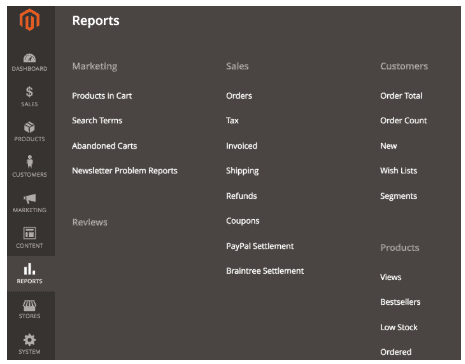
As an example of just how limited this is, it is not possible to run a report on something as simple as ‘best selling categories’ (ie. even Google Analytics is preferable), or a transaction-based order coupon report, only top level coupon info can be gleaned e.g. ‘XYZ coupon was used x times on x date’.
However, anyone on Magento version 2.2.x (i.e. anyone looking into Magento now) has access to a second set of reports: “Magento Advanced Reporting”. This suite is free and involves minimal set up, without the need for a developer. It can be set up directly via the Magento Dashboard (which has some basic graphs itself but in our experience is rarely used in earnest) and is based on Magento BI (Business Intelligence):
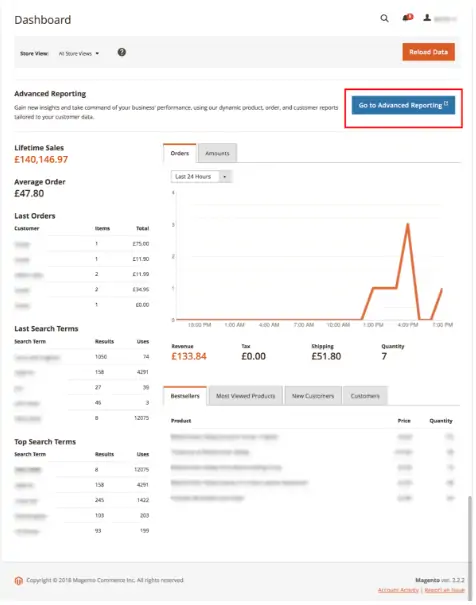
Magento BI is another cloud-based subscription service offered by Magento. This was integrated following their purchase of a business called RJMetrics (in 2016). Not only can Magento BI report on Magento stats in a graphical way, and via multiple customisable dashboards, it can also bring in data from other sources, such as Google Analytics, your ERP (Enterprise Resource Planning) or CRM (Customer Relationship Management) systems. The cost of Magento BI is also based on Gross Merchandise Value, and could set you back anything from $100 to $2,000 per month. It usually requires a development agency to connect up, so even if you take advantage of a free BI trial, you will still have a small expenditure to ensure all is hooked up correctly. We’d only recommend subscribing to Magento BI if: 1) you have no access to in-depth reporting from any other sources e.g. Power BI or JET reporting, 2) you have a sizeable budget, and 3) Magento Advanced Reporting isn’t fulfilling your needs.
Shopify Plus reporting fares better, with 13 detailed sales reports (against Magento’s 8) out of the box and included in your monthly fee, which do include information on Product Type i.e. Category. There are also Reporting and Analytics APIs if these don’t suffice.
Shopify Plus vs Magento: Reporting Summary:
In conclusion, whilst both platforms have a long way to go to be your sole reporting source, Shopify Plus has a higher number of sophisticated reports available out of the box and is ‘free’ (with your Shopify Plus fee).
Consideration 5: International Retail
In terms of product maintenance, historically this has always much easier on Magento, as multiple store views can be managed from the same admin e.g. a product can be live on a French store, a German store and an Italian store, but Ecommerce Managers can control each independently where required, be it product description, sizing or price. Equally, you can make global changes without having to update each individually. Multi-store is still not possible in Shopify Plus and remains a huge benefit of Magento 2 over its competitor.
However, Shopify announced at Unite this summer that multi and some local currencies will finally be rolled out this year (again, date to be confirmed). Hitherto, customers could see pricing in their own currency, using a currency converter, but ultimately they were transacting in the store’s base currency, which could be misleading when not properly explained and certainly might not end up being what the customer actually pays, depending on their bank’s exchange rate. Later this year, this all changes, however with the caveat that only 9 currencies are being rolled out, so if your top converting overseas country doesn’t fall into that list neatly, you might still be waiting some time to reap the benefits.
Thanks to Magento’s multi-store capabilities, local currencies can be taken easily, as long as there’s one store for each currency. Despite Shopify’s recent announcement, in terms of international capabilities, we’d still recommend Magento 2 as it’s tried and tested, currently available and not limited to a set selection of currencies.
Consideration 6: Feature Flexibility
While many of the areas we’ve tackled are quite balanced, Feature Flexibility is an area where Magento Commerce succeeds and Shopify Plus lacks. If your business fits broadly within the range of ‘an average’ ecommerce site’s features, Shopify Plus is likely to be enough for you. If, on the other hand, you have specific requirements around product attributes or promotional options, Magento Commerce is likely to win out.
For example, the Cambridge Satchel Company is a UK-based business currently using Shopify Plus. Their primary product attributes are Colour, Size, and Price. They have an inventory of just a few hundred products:

Shopify Plus allows them to show off the products, photography, and those basic product features. It also allows some extras like personalised initialing, etc.
On the other hand, Design Bestseller is a German-based business, selling roughly 80,000 skus across numerous product categories, in multiple colours, materials, and with numerous product options (for example ‘with headboards’ in beds, vs ‘arm type’ in office chairs, or ‘oak vs ash vs mahogany’ for shelving systems). These are each organised differently per-product category.
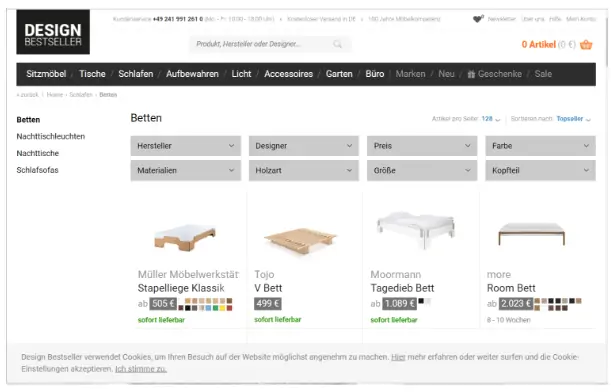
Magento allows them to define different product types with different attributes, to include odd options such as buying particular products with simple small/medium/large sizing vs others by a customer-chosen length to the exact millimetre, and more.
This is a simplistic example comparing 2 retailers, but illustrates a trend that extends to to other areas: The broader your product set, or the closer to ‘unique’ the features your store needs to take into account, the more likely Magento Commerce will be a closer fit than Shopify.
Consideration 7: Scalability
“Scalability” is an ambiguous term. It can mean either the ability to scale to high levels of revenue, or the ability to scale to different business needs.
From the point of view of revenue, traditionally Magento Commerce would have been viewed as the logical option. That has changed a little recently, with headline-grabbing revenue numbers from the likes of Kylie Cosmetics, a beauty brand based on the Shopify Platform, with an estimated 2017 revenue of $330 million.

Market intelligence tool SimilarWeb quotes Kylie Cosmetics’ current traffic at just over 2 million visits per month.
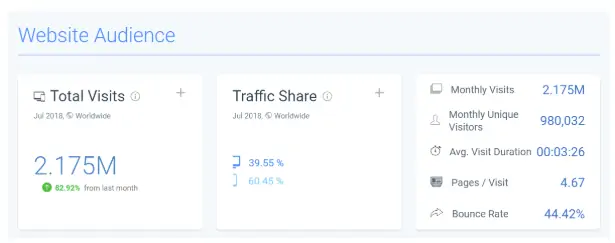
In this case, and similar cases such as Gym Shark, or Palace Skateboards, there seems no limit to the amount of revenue, or traffic, a Shopify store can take.
On the other hand: There are very few of these examples compared to the huge pool of very small retailers using Shopify. And, picking these apart, each business is particularly ‘brand’ led, with a limited set of products and product features.
Magento, in contrast, is recognised by large research agencies such as Gartner as a ‘Leader’ for their ability to execute and completeness of vision. From this perspective, and the aforementioned feature breadth, in its current state, Magento Commerce offers a greater level of scalability to support an expanding Ecommerce business.
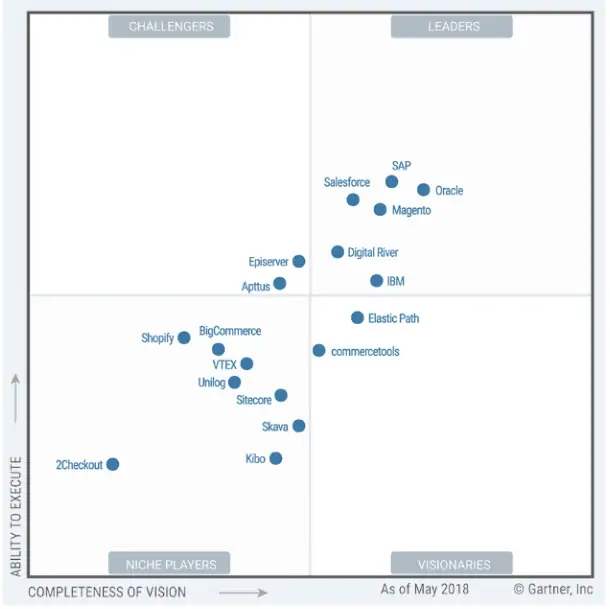
Consideration 8: Future Path
One of the most important considerations when choosing an Ecommerce platform is the likely future path of the business, and the platform itself. Shopify Plus licenses tend not to have long tie-ins. Magento Commerce licence periods can last as short as a year, but equally can last as long as 5-7 years. With this in mind it’s hugely important to be aware of the status of each.
Magento vs Shopify: A Brief History
Shopify’s history is quite straightforward: Founded in 2004, as a spinoff from trying to build an online retail business. The company ticked along at a low level for several years, before becoming perhaps the most recognised small business Ecommerce platform over the last 6 or 7 years.
Historically, Shopify focused at the low end of the market, offering simplicity to smallish retailers. The current CEO is one of the original founders. The business launched on the New York Stock Exchange in 2015. Shopify Plus launched in 2014, as a ‘white glove’ solution. At the time, Shopify said that their core ‘small and medium business’ solution would remain the main focus. Shopify Plus pricing recently increased, and they have rapidly aimed to push toward larger and larger businesses over the last couple of years, with Shopify Plus perhaps switching to be primary focus.
Magento has a more complicated past. Started in 2007, as an alternative to a then-popular platform called osCommerce, it became popular quite quickly, until the business was bought by Ebay in 2011. Magento went from focusing on all sizes of Ecommerce business, to focusing much more toward mid-sized businesses and up. The company then changed hands twice more, and is now owned by Adobe, who finalised acquisition in mid 2018.
Magento 2 Commerce vs Shopify Plus: Current State
Magento had a particularly troubled couple of years in a period where they attempted to launch Magento 2, roughly 5 years after first announcing it. Early releases of Magento 2 were particularly buggy, and it had a poor reputation as a result, meaning several Magento 1 customers left for other platforms. More recently the platform has stabilised, and with Adobe’s acquisition is in a more certain state.
Both Shopify and Magento are therefore very stable from a financial point of view. Shopify has a history with much smaller sites, and has pushed up the food chain over the last few years and is likely to continue to do so. Magento has a recent history with mid-large sites.
From a trajectory point of view, uptake of Shopify has grown rapidly in recent years, whereas Magento has plateaued due in part to uncertainty. Trend lines on these graphs (source: Builtwith), showing very roughly the number of sites using each, tells this story:

Shopify Stability & Future Path Summary:
Shopify Plus is likely to push further up the food chain, increasing the sophistication of the platform, and the types of Ecommerce businesses they serve. Pricing increased recently. We would expect it may do so again, but at an increment that would not put off the type of business currently evaluating it. Feature flexibility has increased particularly in areas around B2B and multinational options. Some functionality has decreased particularly around access to elements like the Payments API, indicating that they intend to maintain their current path of limiting access to develop directly on top of the platform, while allowing simple add ons via their App Marketplace.
Magento Commerce Stability & Future Path Summary:
Magento Commerce is now in a much more stable position, having moved from a wobble around the launch of Magento 2, to ownership by Adobe. They have recruited a strong sales team over recent years, and are now in the position where it’s likely they will integrate with other aspects of Adobe’s ‘Marketing Cloud’. On the basis of this, we predict it likely that pricing may increase, and that – over the next two to three years – it becomes more likely they will push toward even larger businesses than at present. We believe it likely that focus will weigh more heavily toward Magento Commerce Cloud, and that Adobe’s enterprise Analytics, Personalisation, and Campaign Management tools will move toward a single offering.
Shopify Plus vs Magento 2 Commerce: Weighing Up
It’s safe to say that neither platform will do everything you need, out of the box, without the need for developer time or included in the licence fee. The above are 8 criteria we often hear retailers debating, but there are plenty of others, including visual merchandising, CMS, B2B capabilities and shipping options to name but a few.
To decide between the two platforms, it is useful to draw up an in-depth list of functional requirements, and to use a framework such as the MoSCoW method (Must have, Should have, Could have and Won’t have) to prioritise to your own business needs.
If you have multiple inventory locations, lots of integrations with other systems or ambitious plans for international expansion, then it’s likely Magento 2 Commerce would suit you best. If sophisticated reporting is up there as a Must have, your product set is straightforward, and budget and time are real constraints, Shopify Plus should be a great fit and will still scale to your needs, especially as more and more features are rolled out to make it a serious – and more affordable – contender to Magento 2.
Each business is unique. Coming to an informed decision about which platform to choose is not a simple process, but through this guide we attempt to offer core guidance in 8 key areas to help you make that choice on the basis of where your business is now, and where you intend to take it.
